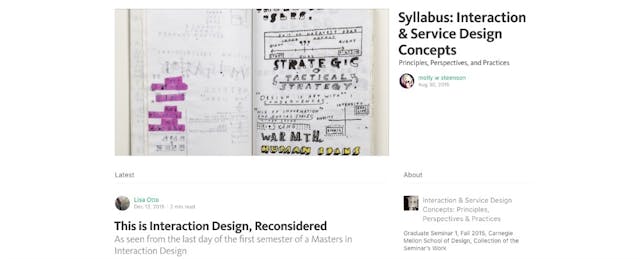If the medium is the message, as Marshall McLuhan famously said decades ago, publishing platform Medium gives students and faculty novel ways to get their ideas across. More than your standard blogging site, Medium is a place where users can write and publish content, and interact with one another to build off of ideas and topics. There are shiny publishing tools, fancy Twitter integrations to share work and algorithms that connect readers to other posts that reflect their interests.
In higher education, the creative platform is becoming a critical thinking tool and a way to create a collaborative learning environment. Students and faculty are using Medium for everything from class discussions to “living syllabuses” to portfolio showcases. While the platform works better for some courses than others—Chem 101 lab work isn’t always shareable—its use in higher ed is growing, especially in the digital humanities.
Jesse Stommel, executive director of the Division of Teaching and Learning Technologies at the University of Mary Washington, is using Medium for his Digital Studies 101 course, which explores the intersection between computers, digital technology, humans and the texts and communities humans make on the web.
Stommel says Medium is a simple platform that students and faculty can get up and running in 15 minutes. “It is an idea for any course, no matter what the discipline, where critical thinking is important—where process is as important as product,” he says.
A Critical Thinking Tool
What does a student assignment on Medium actually look like? As one example, Stommel had his students "rebuild the Internet" using non-digital tools to create an interactive or static representation of the Internet. Next, students published their work on Medium—bringing it back to the digital space—and included an artist’s statement describing their process. One student visually personified the Internet as a superhuman.

Other professors are using Medium as a way for students to learn how to present their work to an audience outside the walls of academia. UMW Associate Professor Zach Whalen chose to use Medium for his English transmedial storytelling class to help students write publicly and understand their work in the context of authentic audiences.
“By using a group blog to create a sustained conversation, we can potentially engage readers in ways that help us think rhetorically about our collective voice,” he explains.
Molly Wright Steenson, associate professor at Carnegie Mellon School of Design, has been using digital platforms in the classroom since she first began teaching in the early 2000s. She’s found that Medium is most effective in seminar-style classes where she wants to encourage students to be reflective.
Steenson says she’s learned that Medium tends to encourage creativity and make students write differently. “They get excited about it; they don’t turn in boring blog posts that I don’t like reading and they don’t like writing,” she says. “It’s a nice tool to use that makes it easy to include images and video to support students’ storytelling in a more fluid manner,” she explains.
Where Syllabuses Can Go Viral
One unique factor that Medium supports is the ability for professors to create a "living syllabus." Both Stommel and Steenson house their syllabuses on Medium and update them as their courses progress.
Since every post on Medium is editable, Stommel says this allows his syllabus and schedule to emerge dynamically over the course of the semester, rather than remaining static.
For Steenson, posting syllabuses helps to engage outsiders who may not be aware of her work in Interaction and Service Design—especially at a master’s degree level. “I like that it allows me to create a syllabus in a narrative sense,” she says. Alumni of programs she’s taught, in addition to well-known interaction designers, read and recommend her innovative postings, such as this syllabus for her Interaction and Service Design Concepts class.
“No one gets excited about your typical paper syllabus, but when you have a document that brings to life the story of the class and what students are doing, then you have something quite different as a result,” she reflects.
Good News, Bad News
With all of Medium’s potential, all three faculty noted specific challenges and downsides they’ve encountered with the platform. They cautioned that faculty shouldn’t force the platform in cases where it doesn’t align with teaching and learning goals.
Steenson says that Medium is not always ideal for collaboration projects because people can’t work on the same page like they can in platforms like WordPress. In Medium, separate articles are put together as a publication. She says Medium is most useful in smaller classes, where it's used for individual student reflections.
Along these same lines, Whalen notes that while Medium is relatively simple for students to use, the user interface isn’t entirely friendly to content management. “Students have found that it’s easy to write and add content, but submitting their article to our publication was not particularly intuitive,” he says. He recommends taking time to think through how the workflow and editorial process will fit into your overall course schedule.
Stommel similarly advises engaging students in thoughtful conversations about the hows and whys of digital work rather than throwing them right into a new online environment.
“As with any tool, there’s no secret sauce for working with Medium,” Stommel admits. “My best advice is to engage students in the what and the why of the tool. Not to merely require students to use the tool for task work, but to ask them to—quite deliberately—consider how they will inhabit the platform.”


